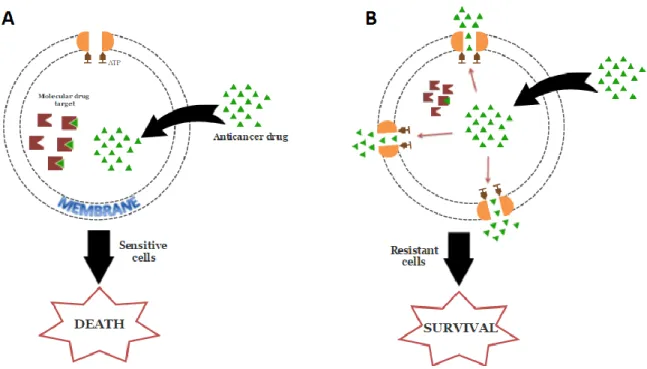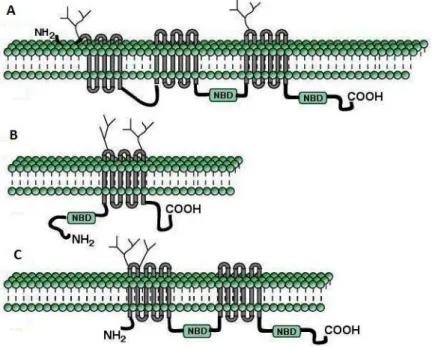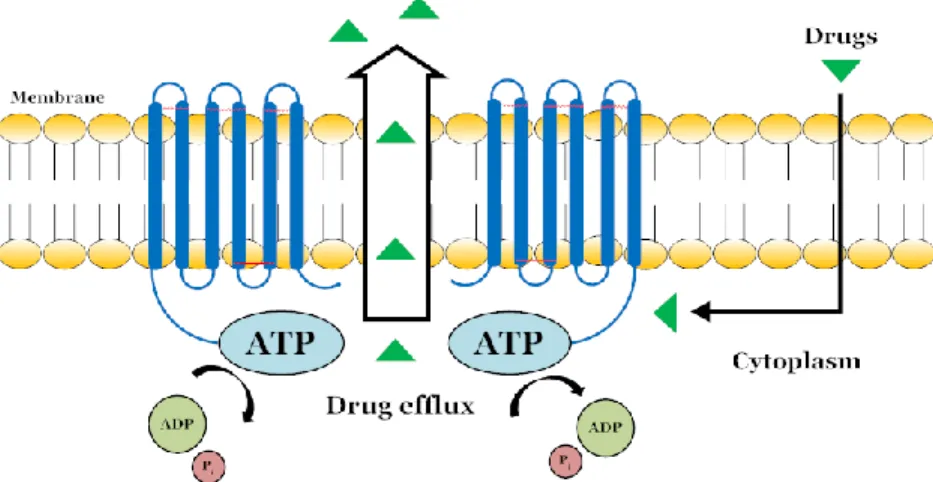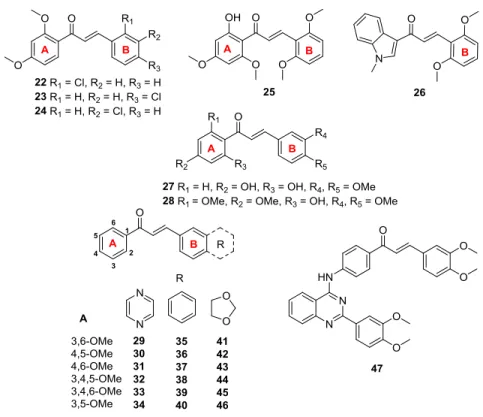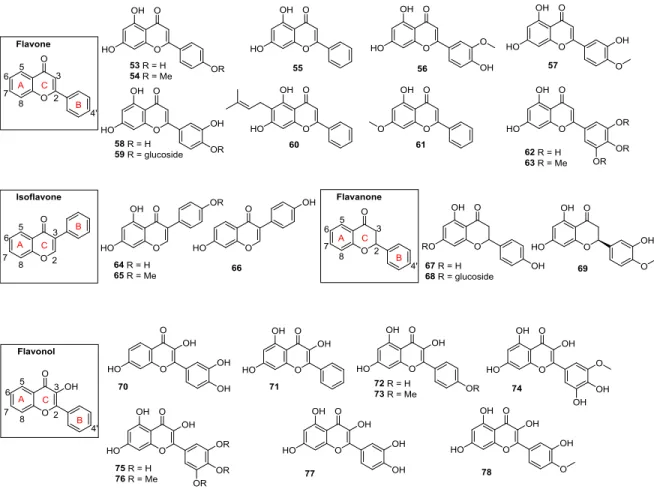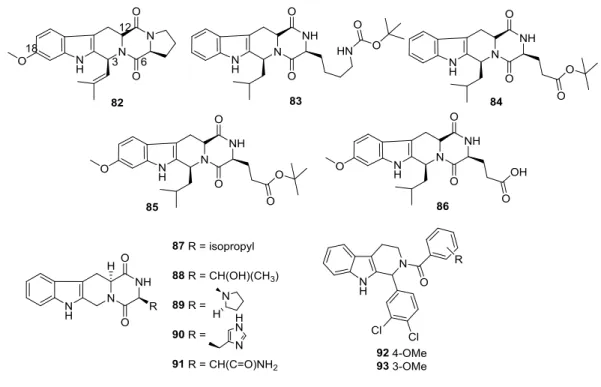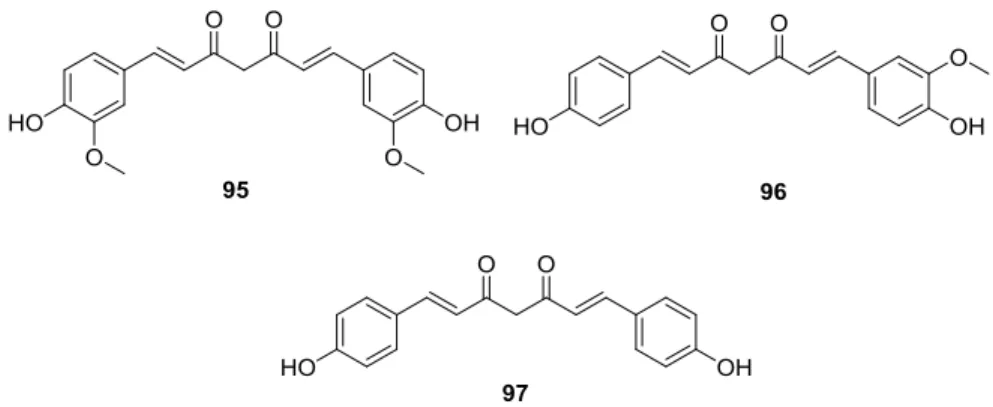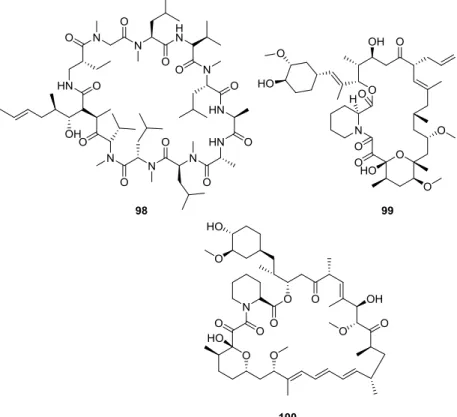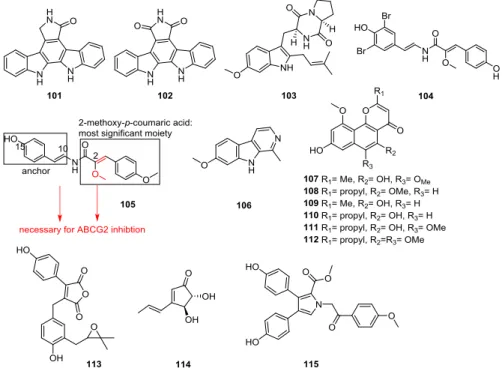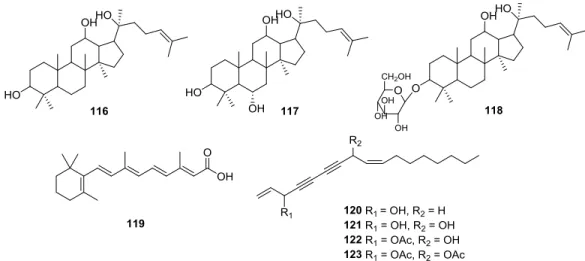New Analogs of Tariquidar: Synthesis, Characterization and Evaluation of their Inhibitory Activity against Breast Cancer
Resistance Protein (ABCG2)
Diana Catherine Peña Solórzano
Universidad Nacional de Colombia Facultad de Ciencias Departamento de Química
Bogotá, Colombia
2016
New Analogs of Tariquidar: Synthesis, Characterization and Evaluation of their Inhibitory Activity against Breast Cancer
Resistance Protein (ABCG2)
Diana Catherine Peña Solórzano
Thesis presented as partial fulfillment of the requirement for the degree of:
Doctor en Ciencias-Química
PhD Advisor:
Dr. rer. nat. Cristian Ochoa Puentes
Macromolecules Research Group
Universidad Nacional de Colombia Facultad de Ciencias Departamento de Química
Bogotá, Colombia
2016
New Analogs of Tariquidar: Synthesis, Characterization and Evaluation of their Inhibitory Activity against Breast Cancer
Resistance Protein (ABCG2)
Diana Catherine Peña Solórzano
Thesis presented as partial fulfillment of the requirement for the degree of:
Doktor der Naturwissenschaften (Dr. rer. nat.)
PhD Advisor (Cotutelle):
Prof. Dr. Burkhard K ö nig
Regensburg University Faculty of Chemistry and Pharmacy
Institute of Organic Chemistry Regensburg, Germany
2016
Dedicated to Ludi,
Carlos, Dres
Acknowledgements
I would like to express my sincere gratitude
My research supervisor Prof. Dr. Cristian Ochoa Puentes for the guidance and assistance
Prof. Dr. Cesar Sierra for his help and support
Prof. Dr. Burkhard König for his support, and for give the opportunity to know another world
Financial support COLCIENCIAS
Prof. Dr. Armin Buschauer and Matthias Scholler for his help with the biological investigations
All members of the Macromolecules Research Group for their support, Meli, Brian, JC, Sandra, William, Camilo, Lau, Tats, Pipe, Karen, Lorena, Pacos, Fredy, Yeimy
All members of the König-group for their help, ideas and support, especially Simone and Manuel
All my friends in Germany, specially Leyre, Ada, Riz, Yeimy for making my stay in Regensburg wonderful and exciting
My parents Carlos and Ludivia who support and accompany with me any time through all of my study
My brother for his help, constant motivation, friendship and love
All my family for their love and support
My friends in Colombia, Ali, Liliam, Cata, Adri
Luna for getting me out of the routine
Oscar for his love, patience, encouragement and understanding
Table of contents
1 General Introduction ... 1
1.1 Multidrug resistance phenomenon ... 2
1.2 ABC transporter superfamily ... 3
1.3 Breast Cancer Resistance Protein (ABCG2) ... 5
1.4 ABCG2 modulators ... 6
1.4.1 Acrylonitriles ... 7
1.4.2 Anti HIV-Based Modulators ... 8
1.4.3 Flavonoids and Chromone Derivatives ... 10
1.4.3.1 Aurones ... 10
1.4.3.2 Chalcones ... 11
1.4.3.3 Chromones ... 13
1.4.3.4 Flavones, Isoflavones, Flavanones, Flavonols and Rotenoids ... 14
1.4.4 Fumitremorgin C (FTC) Analogues ... 19
1.4.5 Natural Product Derivatives ... 21
1.4.5.1 Antibiotics ... 21
1.4.5.2 Curcuminoids ... 22
1.4.5.3 Fungal Metabolites ... 23
1.4.5.4 Miscellaneous Natural Products and their derivatives ... 24
1.4.5.5 Metabolites and others ... 28
1.4.5.6 Stilbenes ... 29
1.4.6 Other Types of Modulators ... 30
1.4.6.1 Acridones ... 30
1.4.6.2 Anthelmintics... 31
1.4.6.3 Hormones ... 31
1.4.6.4 Kinases ... 32
1.4.6.5 Xanthines ... 33
1.4.7 Tariquidar-like Compounds ... 34
1.4.8 Tyrosine Kinase Inhibitor-Based Compounds ... 37
1.4.8.1 Epidermal Growth Factor Receptor (EGFR) Inhibitors ... 37
1.4.8.2 Other TKIs ... 41
1.4.9 Conclusion ... 43
1.5 Aims and Scope ... 45
1.6 References ... 47
2 Tariquidar-like Ketones as Breast Cancer Resistance Protein (ABCG2) modulators .. 1
2.1 Introduction ... 2
2.2 Results and discussion ... 3
2.2.1 Synthesis. Synthesis of compounds 176a-f is shown in scheme 2-1. ... 3
2.2.2 Inhibitory activity evaluation ... 4
2.2.2.1 Inhibitory activity evaluation on breast cancer resistance protein (ABCG2) ... 4
2.2.2.2 Selectivity evaluation. Inhibitory activity evaluation on ABCB1 and ABCC1 ... 7
2.2.3 Chemical stability test in Eagle’s Minimum Essential Medium (EMEM) ... 9
2.2.4 Solubility in Eagle’s Minimum Essential Medium (EMEM) ... 10
2.2.5 Chemosensitivity assay ... 11
2.3 Conclusion ... 12
2.4 Experimental section ... 13
2.4.1 Synthesis and characterization ... 13
2.4.2 Biological investigations... 27
2.4.2.1 Drugs and Chemicals ... 27
2.4.2.2 Cell lines and culture conditions... 27
2.4.2.3 Calcelin-AM microplate assay for the determination of ABCB1 inhibition ... 28
2.4.2.4 Calcelin-AM microplate assay for the determination of ABCC1 inhibition ... 29
2.4.2.5 Hoechst 33342 microplate assay for the determination of ABCG2 inhibition ... 29
2.4.2.6 Chemical Stability in Eagle’s minimum essential medium (EMEM) ... 30
2.4.2.7 Solubility ... 31
2.4.2.8 Chemosensitivity assay ... 31
2.5 References ... 32
3 Synthesis and characterization of ABCG2 modulators combining chalcone, quinoline and isoquinoline moieties ... 35
3.1 Introduction ... 36
3.2 Results and discussion ... 37
3.2.1 Synthesis. Synthesis of compounds 179a-f is shown in Scheme 3-1 ... 37
3.2.2 Inhibitory activity evaluation ... 38
3.2.2.1 Inhibitory activity evaluation on breast cancer resistance protein (ABCG2) ... 38
3.2.2.2 Selectivity evaluation. Inhibitory activity evaluation on ABCB1 and ABCC1 ... 41
3.2.3 Chemical stability test in Eagle’s Minimum Essential Medium (EMEM) ... 43
3.2.4 Solubility in Eagle’s Minimum Essential Medium (EMEM) ... 45
3.2.5 Chemosensitivity assay ... 47
3.3 Conclusion ... 48
3.4 Experimental section ... 50
3.4.1 Synthesis and characterization ... 50
3.4.2 Biological investigations... 59
3.4.2.1 Drugs and Chemicals ... 59
3.4.2.2 Cell lines and culture conditions... 59
3.4.2.3 Calcein-AM microplate assay for the determination of ABCB1 inhibition ... 60
3.4.2.4 Calcein-AM microplate assay for the determination of ABCC1 inhibition ... 61
3.4.2.5 Hoechst 33342 microplate assay for the determination of ABCG2 inhibition ... 61
3.4.2.6 Chemical Stability in Eagle’s minimum essential medium (EMEM) ... 62
3.4.2.7 Solubility tests ... 63
3.4.2.8 Chemosensitivity assay ... 63
3.5 References ... 64
4 Resumen ... 66
5 Appendix: Chapter 2 ... 69
a. Reagents and devices ... 70
a. Synthetic pathways ... 72
b. NMR spectra ... 78
c. HPLC Analysis ... 86
6 Appendix: Chapter 3 ... 90
b. Synthetic pathways ... 91
c. NMR spectra ... 97
d. HPLC Analysis ... 108
7 Publications, posters and conferences ... 112
List of figures
Figure 1-1 Multidrug Resistance Phenomenon. A. Schematic presentation of anticancer drug entry into a cancer cell via membrane. B Schematic presentation of the phenomenon of MDR in cancer cells (Adapted
from Ullah, M. 20083) ... 3
Figure 1-2 Topology and domain arrangement of the ABC transporters ABCC1 (A), ABCG2 (B) and ABCB1 (C) (Adapted from Vautier et al.15) ... 4
Figure 1-3 Schematic molecular mechanism of substrate binding and ATP hydrolysis by ABC transporters .... 6
Figure 1-4 Acrylonitriles ... 8
Figure 1-5 Anti HIV-based modulators ... 10
Figure 1-6 Aurones ... 11
Figure 1-7 Chalcones ... 13
Figure 1-8 Chromones ... 14
Figure 1-9 Flavonoids ... 17
Figure 1-10 Rotenoids ... 18
Figure 1-11 Overview of structural features influencing the inhibition of ABCG2 by flavonoids (green illustrates a positive contribution, red a negative contribution to the inhibitory potency) ... 18
Figure 1-12 Flavones, 7,8-benzoflavones and 5,6-benzoflavones ... 19
Figure 1-13 FTC analogues ... 21
Figure 1-14 Antibiotics ... 22
Figure 1-15 Curcuminoids ... 23
Figure 1-16 Fungal metabolites ... 24
Figure 1-17 Miscellaneous Natural Products and their derivatives ... 27
Figure 1-18 Metabolites and others ... 29
Figure 1-19 Stilbenes ... 30
Figure 1-20 Acridones ... 30
Figure 1-21 Anthelmintics... 31
Figure 1-22 Hormones ... 32
Figure 1-23 Kinases... 33
Figure 1-24 Caffeine ... 33
Figure 1-25 Tariquidar analogues ... 36
Figure 1-26 Triazolic tariquidar analogue ... 36
Figure 1-27 EGFR inhibitors ... 41
Figure 1-28 Other TKIs ... 43
Figure 1-29Main types of Cancer in Colombia and in the world ... 45
Figure 1-30 Some ABCG2 modulators. Tariquidar (141), UR-ME22-1 (143), UR-COP78 (145) ... 46
Figure 2-1 Concentration dependent inhibition of the ABCG2 transporter in MCF-7/Topo cells (Hoechst 33342 assay) by ketones 176a-f. The inhibition is expressed as % relative to the maximal inhibition of ABCG2 by 10 μM of fumitremorgin C (100%) ... 5 Figure 2-2 Effects of ketones 176a-f at 1 and 10 μM concentration on the accumulation of calcein in ABCB1 (A) and ABCC1 (B) overexpressing Kb-V1 and MDCKII cells respectively. Data were normalized by defining the inhibition caused by 10 μM Tariquidar and of 30 μM Reversan as 100 % and are presented as mean ± SD of two independent experiments ... 7 Figure 2-3 Chemical stability of compounds 176a-f incubated in EMEM for 24 h (HPLC analysis, UV detection at 220 nm). ... 10 Figure 2-4 Solubility for ketones in Eagle’s Minimum Essential Medium (EMEM) ... 11 Figure 2-5 Effect of compound 176a in combination with topotecan on proliferating MCF-7/Topo cells:
vehicle (filled black circles, untreated cells), positive control vinblastine [100 nM] (filled blue squares), 176a at concentrations of 10 μM (filled red triangles), 3 μM (filled green diamonds), 1 μM (filled orange stars) and topotecan alone at 100 nM (filled purple circles) ... 12 Figure 3-1 Structure scaffold of chalcone and bioactivities (adapted from Zhou et.al3) ... 36 Figure 3-2 Concentration dependent inhibition of the ABCG2 transporter in MCF-7/Topo cells (Hoechst 33342 assay) by chalcones 179a-f. The inhibition is expressed as % relative to the maximal inhibition of ABCG2 by 10 μM of fumitremorgin C (100%) ... 39 Figure 3-3 Effects of chalcones 179a-f at 1 and 10 μM concentration on the accumulation of calcein in ABCB1 (A) and ABCC1 (B) overexpressing Kb-V1 and MDCKII cells respectively. Data were normalized by defining the inhibition caused by 10 μM Tariquidar and of 30 μM Reversan as 100% and are presented as mean ± SD of two independent experiments. ... 42 Figure 3-4 Chemical stability of compounds 179a-f incubated in EMEM for 24 h (HPLC analysis, UV detection at 220 nm). ... 45 Figure 3-5 Solubility for chalcones 179a-f in Eagle’s Minimum Essential Medium (EMEM) ... 47 Figure 3-6 Effect of compound 179d in combination with topotecan on proliferating MCF-7/Topo cells:
vehicle (filled black circles, untreated cells), positive control vinblastine [100 nM] (filled blue squares), 179d at concentrations of 10 μM (filled red triangles), 3 μM (filled green diamonds), 1 μM (filled orange stars) and topotecan alone at 100 nM (filled purple circles) ... 48
List of tables
Table 2-1 Inhibitory activity evaluation on ABCG2 by reference compound and ketones 176a-f ... 6 Table 2-2 Inhibitory activity evaluation on ABCB1 and ABCC1 by reference compounds and ketones 176a-f .. 8 Table 3-1 Inhibitory activity evaluation on ABCG2 by reference compound and chalcones 179a-f ... 40 Table 3-2 Inhibitory activity evaluation on ABCB1 and ABCC1 by reference compounds and chalcones 179a-f ... 43 Table 5-1 Purities of key compounds ... 86 Table 6-1 Purities of key compounds ... 108
List of Abbreviations
ABC ATP-Binding
Cassette
ABCB1 ATP-binding
cassette sub-family B member 1
ABCC1 ATP-binding
cassette sub-family C member 1
ABCG2 ATP-binding
cassette sub-family G member 2
ADME Absorption,
Distribution, Metabolism, Excretion
ART Antiretroviral
therapy
ATP Adenosine
triphosphate
ATRA All-trans retinoic
acid
AZT Zidothymidine
BBB Blood brain barrier
BCRP Breast Cancer
Resistance Protein Boc
2O Di-tert-butyl
dicarbonate
CsA Cyclosporine A
DCM Dichloromethane
EGFR Epidermal Growth
Factor Receptor
EMEM Eagle’s Minimum
Essential Medium
FLT3 Fms-like tyrosine
kinase 3
FTC Fumitremorgin C
HAART Highly Active
Antiretroviral Therapy HEK293-R482 Cell line HEK293-T482 Cell line
HIV Human
Immunodeficiency Virus
HPLC High Performance
Liquid
Chromatography
HR-MS High Resolution
Mass Spectrometry
IC
50Half Maximal
Inhibitory Concentration
ICZ Indolocarbazole
I
maxMaximun inhibition
IR Infrared
spectroscopy
Kb-V1 Cell line
Log P Partition coefficient
LRP Lung-resistance
Protein
MCF-7 Cell line
MDCKII Cell line
MDR Multidrug
resistance
mRNA Messenger
Ribonucleic Acid
MRP1 Multidrug
Resistance-
associated Protein-
1
MSD Membrane
Spanning Domain
MTX Methotrexate
MX Mitoxantrone
NBD Nucleotide Binding
Domain
NMR Nuclear Magnetic
Resonance
NNRTIs Non-Nucleoside
Reverse Transcriptase Inhibitors
NRTIs Nucleoside
Reverse Transcriptase Inhibitors
NtRTIs Nucleotide
Reverse Transcriptase Inhibitors
P-gp P-glycoprotein
PhA Pheophorbide A
QSAR Quantitative
Structure-Activity Relationship
Quinol Quinolina
rt room temperature
TCBZ Triclabendazole
TCBZSO Triclabendazole
sulfoxide
TCBZSO
2Triclabendazole sulfone
TEA Triethylamine
THIQ Tetrahydroisoqui- noline
TKIs Tyrosine Kinase
inhibitors
TPS-A Tryprostatin A
TsCl p-toluensulfonyl
chloride
VEGFR2 Vascular
Endothelial Growth
Factor
1 General Introduction 1
Multidrug resistance (MDR) in cancer cells is the development of resistance to a variety of structurally and functionally non-related anticancer drugs. This phenomenon has become a major obstacle to cancer chemotherapy seriously affecting the clinical outcome. MDR is associated with increased drug efflux from cells mediated by an energy-dependent mechanism involving the ATP-binding cassette (ABC) transporters, mainly P-glycoprotein (P-gp, ABCB1), the multidrug resistance-associated protein-1 (MRP1, ABCC1) and the breast cancer resistance protein (BCRP, ABCG2). The first two transporters have been widely studied already and ABCG2 is subject of intense study since its discovery as its overexpression has been detected in resistant cell lines in numerous types of human cancers. To date, a long list of modulators of ABCG2 exists and continues to increase.
However, little is known about the clinical consequences of ABCG2 modulation. This fact makes the design of novel, potent and non-toxic modulators of this efflux protein a major challenge to reverse multidrug resistance and thereby increase the success of chemotherapy. The aim of the present chapter is to describe and highlight specific ABCG2 modulators reported to date based on the selectivity of the compounds, as many of them are effective against one or more ABC transport proteins.
1Diana Peña-Solórzanoŧ, Simone Alexandra Starkŧ, Burkhard König, Cesar Augusto Sierra, Cristian Ochoa-Puentes. ABCG2/BCRP: Specific and Non-Specific Modulators. Medicinal Research Reviews. (ŧThese authors (D.P-S and S.A.S) contributed equally to this work. Doi:
10.1002/med.21428
